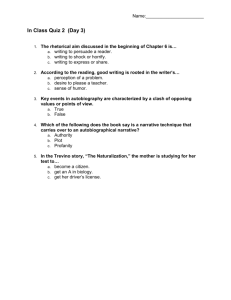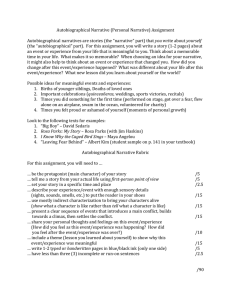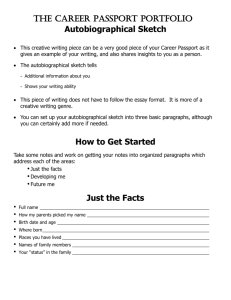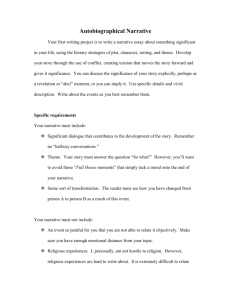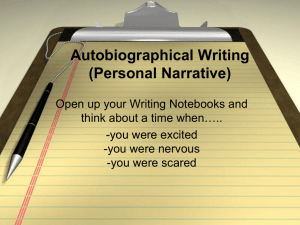Writing a Narrative essay
advertisement
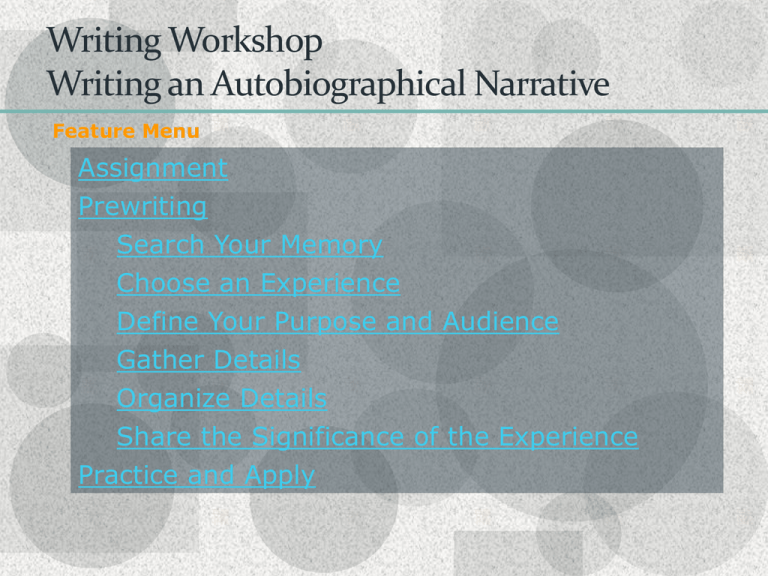
Writing Workshop Writing an Autobiographical Narrative Feature Menu Assignment Prewriting Search Your Memory Choose an Experience Define Your Purpose and Audience Gather Details Organize Details Share the Significance of the Experience Practice and Apply Writing an Autobiographical Narrative Assignment: Write an autobiographical narrative that reveals an experience’s significance for you. Do you have a relative or a friend who tells the same stories over and over again? Many people like to share stories about events that have a special significance to them or that reveal something important about their lives, values, or beliefs. What story will you tell? [End of Section] Writing an Autobiographical Narrative Prewriting: Search Your Memory Think about specific, meaningful experiences from your life. • a special place a neighborhood park, a vacation spot • the first time you did something rode a bike, volunteered • a special occasion a sports event, a family reunion [End of Section] Writing an Autobiographical Narrative Prewriting: Choose an Experience Ask yourself • Is this experience important to me? • What specific details can I give about this experience? • Is the experience too private or embarrassing to share? Choose the experience that brings out the most detailed and positive response from you. [End of Section] Writing an Autobiographical Narrative Prewriting: Define Your Purpose and Audience Purpose • To relate the sequence of events that make up a personal experience • To express to your audience the significance of those events Writing an Autobiographical Narrative Prewriting: Define Your Purpose and Audience Audience • Teachers • Friends • Classmates • Parents • Others who will read your autobiographical narrative What background information will the audience need to understand the experience? [End of Section] Writing an Autobiographical Narrative Prewriting: Gather Details List all the vivid details you can recall about events, people, places, thoughts, and feelings. Events What sequence of events make up the experience? Were there important events that led up to or followed the experience? Tip Match the pace of your narrative to the pace of the actual events—a quick pace for rapid events, a slow pace for more drawn-out events. Sequence of events: volunteered for beach clean-up, found an injured turtle and got it help Later events: volunteered at an animal rescue shelter, decided to become a veterinarian Writing an Autobiographical Narrative Prewriting: Gather Details List all the vivid details you can recall about events, people, places, thoughts, and feelings. Places Where did the events happen? Tip Use concrete sensory details to create effective images of the sights, sounds, and smells of the places you are describing. Beach on a spring afternoon; cool breeze from the sea; warm, white sand; calm water; salty air Writing an Autobiographical Narrative Prewriting: Gather Details List all the vivid details you can recall about events, people, places, thoughts, and feelings. People Who was involved in the events? What did those people look like? What did they do and say? Tip Use sensory details to describe actions and gestures. Use dialogue, actual words people say, to show each person’s personality. Me—ages fifteen and sixteen Dr. Alice Monroe—animal rescue veterinarian; friendly; gentle with animals; always takes time to explain treatments Writing an Autobiographical Narrative Prewriting: Gather Details List all the vivid details you can recall about events, people, places, thoughts, and feelings. Thoughts and Feelings What did I think and feel as the events unfolded? Tip Use interior monologue, “thinking out loud,” to share your thoughts with readers. Excitement to volunteer, worry about the injured turtle, respect and admiration for the people at the animal rescue shelter [End of Section] Writing an Autobiographical Narrative Prewriting: Organize Details Discuss the events in chronological order, or time order. First Next Last Background Discuss events that came before your experience to help your audience understand what led up to it. Main narrative Discuss events that were part of your meaningful life experience. Conclusion Discuss events that came after your experience to show how that experience related to other parts of your life. Writing an Autobiographical Narrative Prewriting: Organize Details Use transitional words and phrases to guide your readers through the events in your narrative. Changes in Time Changes in Place at first before around nearby to begin later across from next to then next beside behind afterwards last in front of under [End of Section] Writing an Autobiographical Narrative Prewriting: Share the Significance of the Experience Ask yourself • Did the experience change me? If so, how? • What did I learn from the experience? • Has my perspective, my thoughts and feelings about the event, shifted over time? If so, how? Writing an Autobiographical Narrative Prewriting: Share the Significance of the Experience Write a sentence identifying your controlling impression—the main idea or feeling you want to communicate about your experience. Rescuing the injured turtle and volunteering at the animal rescue shelter has given me a new respect for animals and a sense of accomplishment and purpose. You don’t have to include this sentence in your final draft, but every detail in the narrative should contribute to the controlling impression. [End of Section] Writing an Autobiographical Narrative Prewriting: Practice and Apply Follow the guidelines in this section to choose an experience, analyze your audience, and gather and organize details for your autobiographical narrative. [End of Section] The End
